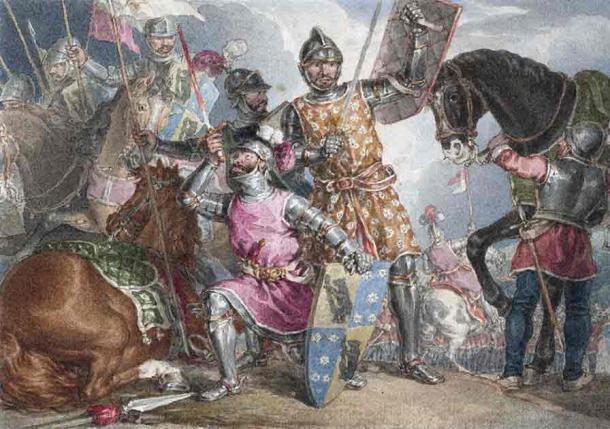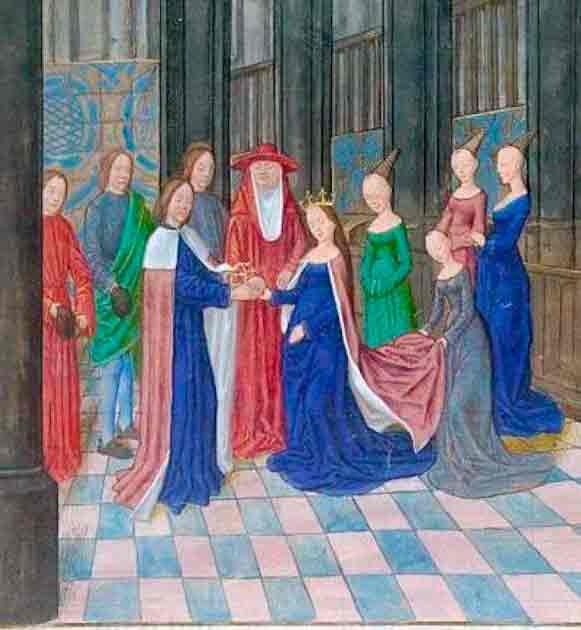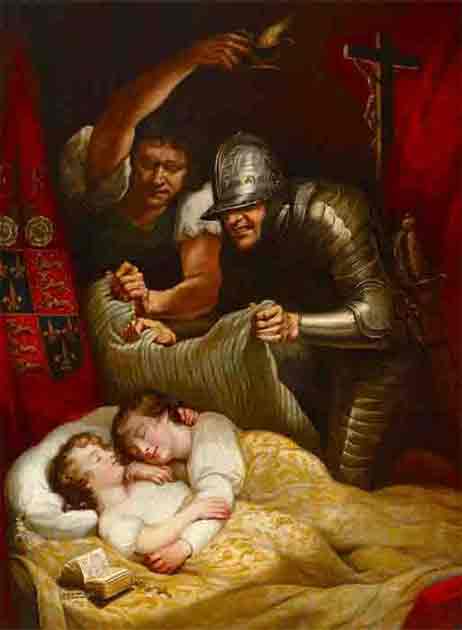
A Brief History of Edward IV of England, The First Yorkist King
Governing a great and powerful realm is certainly no easy task, especially a kingdom that was as powerful as medieval England. The Kings of England were amongst the most powerful men of that time, and many desired to sit on its throne. Due to this incessant desire for power, England experienced a troublesome period filled with strife, betrayals, intrigues, and death. It was known as the Wars of the Roses and saw a number of prominent people vying for England’s power. One of these people was Edward IV, the central figure of the wars.
- Unemployment Under Edward VI Was Punished with Branding and Slavery
- Skeletons of Woman and Child Found Beneath Tower of London
Edward IV of England and the Wars for the Throne
Edward IV of England, a key figure in the turbulent period known as the Wars of the Roses, ascended to the English throne in 1461, marking the beginning of a pivotal era in English history. Born on April 28, 1442, Edward was the eldest son of Richard, Duke of York, and Cecily Neville. His early life was shaped by the political turmoil of his time, as England was embroiled in a bitter struggle for power between the houses of Lancaster and York.
Edward's father, Richard, Duke of York, had a claim to the throne through his direct descent from Edward III of Windsor. This claim, coupled with dissatisfaction with the rule of the Lancastrian King Henry VI, led to a series of armed conflicts known as the Wars of the Roses.
Edward's upbringing was heavily influenced by his father's ambitions and the factional politics of the nobility. The turning point in Edward's life came in 1460 when his father was killed at the Battle of Wakefield, leaving Edward as the de facto head of the House of York. Determined to assert his claim to the throne, Edward led the Yorkist forces to a decisive victory at the Battle of Towton in 1461, where he was proclaimed king. At the age of just 18, Edward became the first Yorkist monarch, marking the beginning of his tumultuous reign.
- Strange Deaths in History: The Duke who Died in a Barrel of Wine
- Bloody Mary: Tumultuous Beginnings for A Future Queen of England

Three key players in the Battle of Towton, the Earl of Warwick, Edward IV and Richard III are depicted in a painting by John Augustus Atkinson (1775-18833). (Public Domain)
“The Battle of Towton was fought on March 29th, 1461, under heavy snowfall in an almost fantastical ambience. The two armies, together numbering roughly 60,000 men, advanced towards each other in what was a true “duel of the fates”. [...] It was unarguably the bloodiest battle ever fought on English soil: some estimates propose roughly 20,000 Lancastrians killed, and 8,000 to 12,000 thousand dead Yorkists.”
Aleksa Vučković, “Wars of the Roses”, History Nerds Publishing
The King’s Claims Challenged
Edward's reign was characterized by both military prowess and political intrigue. He faced numerous challenges to his authority, both from rival claimants to the throne and from discontented nobles within his own ranks. One of his most formidable adversaries was Henry VI, who was briefly restored to the throne in 1470 with the support of the powerful Earl of Warwick, known as the "Kingmaker." However, Edward's resilience and military skill enabled him to reclaim the throne the following year, cementing his position as the undisputed king of England.
Edward was noted as a very capable military commander, and he won a number of major victories during the war. The most important one was the Battle of Towton. Edward's victory at Towton was the result of careful planning, strategic maneuvering, and tactical brilliance. Despite being outnumbered by the Lancastrian forces, Edward's army held the high ground, giving them a significant advantage in the ensuing battle. The Yorkist archers, positioned on the slopes of Towton Hill, unleashed a devastating barrage of arrows on the advancing Lancastrian troops, inflicting heavy casualties and causing chaos within their ranks.
One of the defining features of Edward's reign was his skillful manipulation of the nobility. He rewarded his loyal supporters with lands and titles, effectively consolidating his power base and neutralizing potential threats. At the same time, he ruthlessly suppressed dissent, executing, or exiling those who opposed him. This combination of carrot and stick allowed Edward to maintain a relatively stable reign despite the ongoing factionalism of the nobility.
Edward's reign was also marked by significant cultural and economic developments within his realm. He was a patron of the arts and literature, fostering a vibrant cultural scene at his court. He also encouraged trade and commerce, promoting policies that stimulated economic growth and prosperity. Under his rule, England experienced a period of relative stability and prosperity, laying the foundations for the later achievements of the Tudor dynasty.
However, Edward's reign was not without its controversies. His marriage to Elizabeth Woodville, a commoner of relatively low birth, scandalized the nobility and caused friction within his own family. The Woodville family's rapid rise to prominence and the favoritism shown to them by the king alienated many of Edward's former supporters, leading to resentment and discontent. What is more, Edward's marital bliss was not without its challenges. Rumors swirled about his extramarital affairs, including a notorious liaison with Jane Shore, one of Elizabeth Woodville's ladies-in-waiting. These scandals tarnished Edward's reputation and provided fodder for his enemies, who sought to undermine his authority by attacking his personal integrity.

The marriage of Edward IV and Elizabeth Woodville. (Public Domain)
Edward's health also began to decline in his later years, further exacerbating the political tensions that simmered beneath the surface. Many chalked up his increasingly fragile health to his use of emetics. Emetics are substances that induce vomiting, often used for medicinal purposes. Their use in medieval England was not uncommon, particularly as a means of purging the body of perceived toxins or impurities. Physicians of the time believed in the therapeutic benefits of inducing vomiting to cleanse the system and restore health. However, the line between legitimate medical treatment and malicious intent could often blur, especially in the context of the cutthroat politics of the era.
Malicious Health Practices of the Middle Ages
Edward was known for his heavy use of emetics, with whose “help” he could gorge himself at meals, induce vomiting, and then return to eat once again, his stomach empty. Needless to say, that this voracious lifestyle was harmful, and his health took a heavy blow. By Easter 1483, he became fatally ill, and was on his deathbed. Hastily he managed to add important codicils to his will, naming his own brother as Protector of the Realm after his death.
His sudden death on April 9th, 1483, plunged England into a renewed period of instability, as his young son and heir, Edward V, was then caught up in a bitter power struggle between rival factions. This tumultuous period, known as the Wars of the Roses, would ultimately culminate in the rise of the Tudor dynasty and the establishment of the modern English monarchy.
The fate of Edward IV's young son, Edward V, is one of the most tragic and enigmatic episodes in English history. Following Edward IV's sudden death, the 12-year-old Edward V was supposed to ascend to the throne as the rightful heir. However, this never occurred, and was overshadowed by the machinations of his uncle, Richard, Duke of Gloucester, who would later become King Richard III. Richard, who had been appointed as Lord Protector to oversee the governance of the realm during Edward V's minority, moved swiftly to consolidate his own power and eliminate potential threats to his authority.

16th century portrait of Richard III of England. (Public domain)
One of Richard's first actions was to intercept Edward V on his journey to London for his coronation. He intercepted the young king and his entourage at Stony Stratford and escorted them to London under the pretext of ensuring Edward's safety. However, once in London, Richard took decisive action to secure his grip on power.
“Queen Elizabeth Woodville instructed her brother, Earl Rivers, to promptly escort her son Edward V to London - alongside an armed escort of 2,000 men. Richard of Gloucester reacted accordingly, and on April 30th, 1483, he had the Earl Rivers, and several other nobles arrested and sent to the north, where they would not be a threat to him. He then swiftly moved southwards and seized the boy-king Edward V en route to London. The Queen Mother sought sanctuary within Westminster Abbey, while Richard placed his young nephews, sons of Edward IV, into the Tower of London. The boys were Edward V and and his younger brother, the little boy Richard of Shrewsbury, Duke of York.”
Aleksa Vučković, “Wars of the Roses”, History Nerds Publishing
The Princes in the Tower
In a shocking turn of events, Richard had himself proclaimed king, citing the supposed illegitimacy of Edward V and his sibling. Edward V and his brother were declared illegitimate and were confined to the Tower of London, ostensibly for their own safety. However, their fate remains a subject of speculation and debate. Historians have long debated what happened to the "Princes in the Tower," as Edward V and his brother came to be known. The most widely accepted theory is that they were murdered on the orders of Richard III, who saw them as potential threats to his reign. Their disappearance sparked outrage and condemnation, tarnishing Richard's reputation and fueling rumors of his ruthlessness and ambition.

The Murder of the Princes in the Tower. Did Richard III really order the execution of his nephews Edward V and Prince Richard? (Public domain)
In 1674, during renovations at the Tower of London, the skeletons of two children were discovered beneath a staircase. While many believed these to be the remains of the princes, conclusive evidence has been elusive, and their identities remain unconfirmed. The fate of Edward V and his brother remains one of the enduring mysteries of English history, a poignant reminder of the dark and treacherous politics of the Wars of the Roses. It was also a major stain on the legacy of Edward IV, whose sons paid with their lives just for being of royal birth.
In conclusion, Edward IV of England was a pivotal figure in English history, whose reign marked the transition from the medieval to the early modern period. His military skill, political acumen, and patronage of the arts left a lasting legacy that shaped the course of English history for generations to come. Though his reign was not without its challenges and controversies, Edward's leadership ultimately laid the foundations for the stability and prosperity of the Tudor era.
Top image: Posthumous portrait of King Edward IV from original circa 1470-1475. Source: Public Domain
References
Goodman, A. 1990. The Wars of the Roses: Military Activity and English Society, 1452-97. Taylor & Francis.
Panton, J. 2011. Historical Dictionary of the British Monarchy. Scarecrow Press.
Ross, C. 1998. Edward IV. Yale University Press.
Vučković, A. 2022. The Blood-Soaked Throne: The Wars of the Roses, 1455-1487. History Nerds Publishing.















